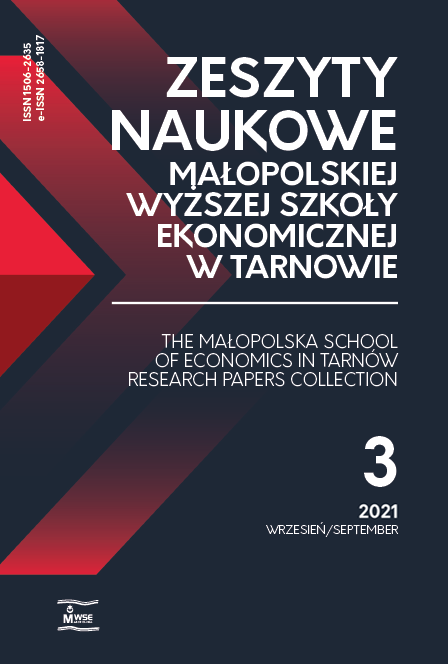Abstract
Cryptocurrencies have become an essential element of the global financial system, and in recent years also a frequent investment tool. The aim of the study is to check whether investments in cryptocurrencies are more effective than in commodities on commodity exchanges. The study was conducted based on the daily quotations of the analyzed instruments in 2011–2020. The investment efficiency level was estimated using Sharpe’s and Sortino’s indicators. The research results showed that, on average, over the entire period under study, investments in cryptocurrencies were burdened with the highest risk, but at the same time achieved the highest daily rates of return. As a result, they were much more effective investment tools than gold, silver and WTI. The advantage of cryptocurrencies could be due to the long-term persistence of ultra-low interest rates and the reduced attractiveness of investment in debt securities. Bitcoin and etherum with the largest shares in cryptocurrency market capitalization have proven to be the most effective investment tools.
References
Aslanidis, N., Bariviera, A. F., Martínez-Ibáñez, O. (2019). An analysis of cryptocurrencies conditional cross correlations. Finance Research Letters, 31, 130–137. DOI: 10.1016/j.frl.2019.04.019.
View in Google Scholar
Baur, D. G., Lee, A. D., Hong, K. (2018). Bitcoin: medium of exchange or speculative assets? Journal of International Financial Markets, Institutions and Money, 54, 177–189. DOI: 10.1016/j.intfin.2017.12.004.
View in Google Scholar
Damianov, D. S., Elsayed, A. H. (2020). Does Bitcoin add value to global industry portfolios? Economics Letters, 19(C). DOI: 10.1016/j.econlet.2019.108935.
View in Google Scholar
García-Jorcanoa, L., Benito, S. (2020). Studying the properties of the Bitcoin as a diversifying and hedging asset through a copula analysis: Constant and time-varying. Research in International Business and Finance, 54(C). DOI: 10.1016/j.ribaf.2020.101300.
View in Google Scholar
Gronwald, M. (2019). Is Bitcoin a commodity? On price jumps, demand shocks, and certainty of supply. Journal of International Money and Finance, 97, 86–92. DOI:10.1016/j.jimonfin.2019.06.006.
View in Google Scholar
Hong, K. (2017). Bitcoin as an alternative investment vehicle. Information Technology and Management, 18, 265–275. DOI: 10.1007/s10799-016-0264-6.
View in Google Scholar
Hung, P. K., Ly, S., Lu, R., Hoang, T. H. V., Wong, W. K. (2021). Is Bitcoin a better portfolio diversifier than gold? A copula and sectoral analysis for China. International Review of Financial Analysis, 74. DOI: 10.1016/j.irfa.2021.101674.
View in Google Scholar
Kang, S. H., Yoon, S. M., Bekiros, S., Uddin, G. S. (2020). Bitcoin as hedge or safe haven: Evidence from stock, currency, bond and derivatives markets. Computational Economics, 56, 529–545. DOI:10.1007/s10614-019-09935-6.
View in Google Scholar
Liu, W. (2019). Portfolio diversification across cryptocurrencies. Finance Research Letters, 29, 200–205. DOI: 10.1016/j.frl.2018.07.010.
View in Google Scholar
Majdoub, J., Sassi, S. B., Bejaoui, A. (2021). Can fiat currencies really hedge Bitcoin? Evidence from dynamic short-term perspective. Decisions in Economics and Finance. DOI: 10.1007/s10203-020-00314-7.
View in Google Scholar
Michalczyk, W. (2018). Główne zależności pomiędzy poziomem dochodu, ryzyka i rozpowszechnienia najważniejszych kryptowalut. Studia Ekonomiczne – Zeszyty Naukowe Uniwersytetu Ekonomicznego w Katowicach, 372, 71–83.
View in Google Scholar
Okorie, D. I. (2020). Did China’s ICO ban alter the Bitcoin market? International Review of Economics & Finance, 69, 977 993. DOI: 10.1016/j.iref.2020.05.016.
View in Google Scholar
Qarni, M. O., Gulzar, S. (2021). Portfolio diversification benefits of alternative currency investment in Bitcoin and foreign exchange markets. Financial Innovation, 7. DOI: 10.1186/s40854-021-00233-5.
View in Google Scholar
Rehman, M. U. (2020). Do Bitcoin and precious metals do any good together? An extreme dependence and risk spillover analysis. Resources Policy, 68, 1–16. DOI: 10.1016/j.resourpol.2020.101737.
View in Google Scholar
Reuters.com. (2021). Global Market Data [online, accessed: 2021-06-02]. Retrieved from: https://www.reuters.com/markets/global-market-data.
View in Google Scholar
Sortino, F., Price, L. (1994). Performance measurement in a downside risk framework. Journal of Investing, 30, 1519–1533.
View in Google Scholar
Stensås, A., Nygaard, M. F., Kyaw, K., Treepongkaruna, S. (2019). Can Bitcoin be a diversifier, hedge or safe haven tool? Cogent Economics & Finance, 7(1), 1–21. DOI: 10.1080/23322 039.2019.1593072.
View in Google Scholar
UKNF. (2021). Ostrzeżenie Urzędu KNF o ryzykach związanych z nabywaniem oraz z obrotem kryptoaktywami [online, accessed: 2021-06-25]. Retrieved from: https://www.knf.gov.pl/knf/pl/komponenty/img/Ostrzezenie_UKNF_o_ryzykach_zwiazanych_z_nabywaniem_oraz_z_obrotem_kryptoaktywami_72241.pdf.
View in Google Scholar
Wang, P., Zhang, W., Li, X., Shen, D. (2019). Is cryptocurrency a hedge or a safe haven for international indices? A comprehensive and dynamic perspective. Finance Research Letters, 31(C), 1–18. DOI: 10.1016/j.frl.2019.04.031.
View in Google Scholar
Wyderka, D., Saganowski, T. (2018). Efektywność inwestycji na rynku kryptowalut i inwestycji na rynku giełdowym – ujęcie porównawcze. Finanse i Prawo Finansowe, 3(19), 67–77. DOI: 10.18778/2391-6478.3.19.06.
View in Google Scholar

This work is licensed under a Creative Commons Attribution-NonCommercial-NoDerivatives 4.0 International License.

